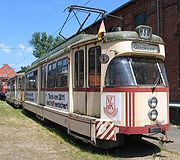
TW 400
Encyclopedia

Tram
A tram is a passenger rail vehicle which runs on tracks along public urban streets and also sometimes on separate rights of way. It may also run between cities and/or towns , and/or partially grade separated even in the cities...
vehicle formerly used on the tramways of Hanover
Hanover
Hanover or Hannover, on the river Leine, is the capital of the federal state of Lower Saxony , Germany and was once by personal union the family seat of the Hanoverian Kings of Great Britain, under their title as the dukes of Brunswick-Lüneburg...
, Germany
Germany
Germany , officially the Federal Republic of Germany , is a federal parliamentary republic in Europe. The country consists of 16 states while the capital and largest city is Berlin. Germany covers an area of 357,021 km2 and has a largely temperate seasonal climate...
, built from 1956 to 1958 by Düwag. Some units underwent remodeling to prepare them for being used on the Hanover Stadtbahn
Hanover Stadtbahn
The Hanover Stadtbahn is a Stadtbahn light rail system in the city of Hanover, Germany that opened in September 1975, gradually replacing the city's tramway network over the course of the following 25 years. As of 2005, it transports 115 million passengers per year...
network but they were never used for this purpose.
During the construction of the A tunnel of the Hanover Stadtbahn it was not foreseeable whether the new TW 6000
TW 6000
The TW 6000 is a type of articulated light rail vehicle used on the Hanover Stadtbahn system, originally manufactured by Düwag, AEG, Kiepe and Siemens, the later batches being built by LHB ....
cars would be available in sufficient numbers. Therefore, a number of TW 400 cars (called Breitraumwagen because of their body width of 2.35 metres), was brought up to tunnel standards from 1969 onwards.
This involved:
- Folding steps
- Rearrangement of the doors
- wide door steps (dubbed "Blumenbretter" or "window sills"), bridging the gap between the tramcar and the platform.
Since the tram cars were unidirectional vehicles, all stations on the A line have their platforms on the right in direction of travel. This led to some problems, most notably the complicated layout of the station Lister Platz, with platforms stacked on top of each other. The Lahe terminus also was equipped with a turning loop to allow the TW 400 cars to turn around.
In the end, when the Stadtbahn system opened in 1975, there was a large enough number of TW 6000
TW 6000
The TW 6000 is a type of articulated light rail vehicle used on the Hanover Stadtbahn system, originally manufactured by Düwag, AEG, Kiepe and Siemens, the later batches being built by LHB ....
available and so the TW 400 never were used in the tunnels. They used to run on the tramway lines and were put out of service in the late 1970s and early 1980s. Most of them were consequently scrapped. The tunnel-enabled unit 427, together with trailer 1424, has been preserved at the HSM
Hannoversches Straßenbahn-Museum
The Hannoversches Strassenbahn-Museum or Hanover Tramway Museum comprises a collection of tramcars from all over Germany, and is located on the site of a former potash mine in Sehnde, southeast of the city of Hanover.- External links :**...
in Sehnde
Sehnde
Sehnde is a town in Lower Saxony, Germany. It is located approx. 15 kilometres southeast of Hanover.-History:Sehnde was formed in 1974 by combining fifteen autonomous villages which belonged to three different districts: Bilm, Bolzum, Dolgen, Evern, Gretenberg, Haimar, Hoever, Ilten, Klein Lobke,...
.

